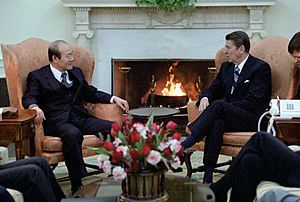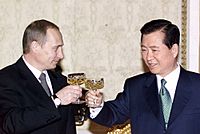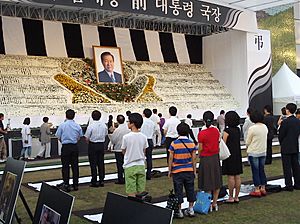Kim Dae-jung facts for kids
Quick facts for kids
Kim Dae-jung
|
|
|---|---|
|
김대중
金大中 |
|

Official portrait, 1998
|
|
| 8th President of South Korea | |
| In office 25 February 1998 – 24 February 2003 |
|
| Prime Minister | Kim Jong-pil Park Tae-joon Lee Han-dong Chang Sang Chang Dae-whan Kim Suk-soo |
| Preceded by | Kim Young-sam |
| Succeeded by | Roh Moo-hyun |
| President of the Millennium Democratic Party | |
| In office 20 January 2000 – 8 November 2001 |
|
| Preceded by | Position established (as President of the National Congress for New Politics) |
| Succeeded by | Han Kwang-ok (acting) |
| President of the National Congress for New Politics | |
| In office 5 September 1995 – 20 January 2000 |
|
| Preceded by | Position established |
| Succeeded by | Position abolished (as President of the Millennium Democratic Party) |
| Member of the National Assembly | |
| In office 30 May 1988 – 19 December 1992 |
|
| Constituency | Proportional Representation |
| In office 1 July 1971 – 17 October 1972 |
|
| Constituency | Proportional Representation |
| In office 17 December 1963 – 30 June 1971 |
|
| Constituency | Mokpo (South Jeolla) |
| In office 14 May 1961 – 16 May 1961 |
|
| Constituency | Inje (Gangwon) |
| Personal details | |
| Born | 6 January 1924 Hauido, Korea |
| Died | 18 August 2009 (aged 85) Seoul, South Korea |
| Resting place | Seoul National Cemetery |
| Political party | Democratic |
| Other political affiliations |
Democratic (1955–1961, 1963–1965) People (1965–1967) New Democratic (1967–1972) Reunification Democratic (1987) Peace Democratic (1987–1991) Democratic (1991–1995) National Congress (1995–2000) |
| Spouses |
Cha Yong-ae
(m. 1945; died 1959) |
| Children | 3 |
| Education | Mokpo Commercial High School |
| Awards | Nobel Peace Prize (2000) Philadelphia Liberty Medal (1999) |
| Religion | Catholic (Christian Name: Thomas More) |
| Signature | |
| Military service | |
| Allegiance | |
| Branch/service | |
| Rank | Student Soldier |
| 'Kim Dae-jung or Kim Dae Jung' | |
| Hangul |
김대중
|
|---|---|
| Hanja |
金大中
|
| Revised Romanization | Gim Dae(-)jung |
| McCune–Reischauer | Kim Taejung |
| Art name | |
| Hangul |
후광
|
| Hanja |
後廣
|
| Revised Romanization | Hugwang |
| McCune–Reischauer | Hugwang |
Kim Dae-jung (Korean: 김대중; Hanja: 金大中; Korean pronunciation: [kim.dɛ.dʑuŋ]; 6 January 1924 – 18 August 2009) was a South Korean politician and activist. He served as the eighth president of South Korea from 1998 to 2003.
He won the Nobel Peace Prize in 2000. This was for his efforts to bring democracy and human rights to South Korea and East Asia. He also worked for peace and understanding with North Korea and Japan. He is the only Korean person to have won the Nobel Prize so far. People sometimes called him "the Nelson Mandela of Asia" because he fought for freedom. Kim was the first opposition candidate to become president.
Contents
Early Life and Challenges
Kim Dae-jung was born on January 6, 1924. He later changed his birth date to December 3, 1925, to avoid being forced into the army under Japanese rule. He was one of seven children. His family moved to the port city of Mokpo so he could finish high school.
In 1944, Kim finished Mokpo Commercial Middle School. He then worked at a Japanese shipping company. After Japan lost World War II, Korea became free. Kim became the head of the company's management. In 1947, he started his own shipping company. He also became a newspaper publisher in Mokpo in 1948.
When the Korean War started in June 1950, Kim was in Seoul. On his way back to Mokpo, North Korean communists captured him. He was sentenced to be shot, but he managed to escape.
Starting in Politics
Kim left his business to focus on politics in 1954. He tried to win elections four times but was not successful at first. In 1956, he became a spokesperson for the opposition Democratic Party.
Kim's first wife, Cha Yong-ae, passed away in 1959. After this, Kim became a Catholic.
He was elected to the National Assembly on May 14, 1961. However, two days later, Park Chung-hee took power in a military coup. This made the elections invalid. Kim was briefly arrested but later got his rights back.
In 1962, Kim married Lee Hee-ho, who was a Christian activist. They had one son together. Kim won a seat in the National Assembly in 1963 and 1967. He became an important leader for the opposition.
1971 Presidential Campaign
In 1970, Kim finished a master's course in economics. He then ran for president in 1971 against President Park Chung-hee. President Park had changed the rules so he could run for a third term. Kim was a great speaker and had strong support from his followers. He won the nomination from the opposition party.
Kim promised to help the economy benefit everyone. He also wanted to ease tensions with North Korea. He warned that if Park was reelected, he would become a dictator.
Kim received huge support from his home region of Jeolla. He got over 95% of the votes there, which is still a record. He did very well in the election, getting 45% of the votes against Park. This was impressive because the government made it hard for him to campaign. Park saw Kim as a threat to his power.
Challenges and Exile
One month after the election, Kim was campaigning for other elections. A truck crashed into his car, seriously injuring him and his aides. He hurt his hip and had a limp for the rest of his life. Many believed this was an attempt to harm him by Park's government. Soon after, Kim went to Japan. President Park then took more power and created a strict new constitution in 1972.
Kidnapped by KCIA
In August 1973, Kim was almost killed. He was kidnapped from a hotel in Tokyo by agents from the KCIA. This happened because he spoke out against President Park's new strict rules.
The US ambassador in Seoul, Philip Habib, helped Kim. Kim was returned to South Korea but was put under house arrest. He was not allowed to be involved in politics. In 1976, he was put in prison for five years for speaking out against the government. This was later changed to house arrest in December 1978. During this time, Amnesty International called him a "prisoner of conscience."
In 2007, the National Intelligence Service (the KCIA's new name) admitted that the KCIA had kidnapped Kim. They said they had planned to kill him and throw him into the sea. The agency said President Park likely knew about it.
Death Sentence and Exile
After President Park was assassinated in December 1979, Kim's political rights were briefly restored. But then, Major General Chun Doo-hwan took power.
Chun's new government started to crack down on people. They falsely accused Kim of causing the uprising in Gwangju in May 1980. Gwangju was a strong support area for Kim. He was arrested and sentenced to death in September 1980.

Many people around the world asked for Kim's life to be spared. Pope John Paul II sent a letter to President Chun Doo-hwan. The US government also stepped in. They told Chun that the new US President, Ronald Reagan, did not want Kim to be executed. Chun wanted to be accepted by the US, so he agreed to change Kim's death sentence to 20 years in prison. In return, he was invited to visit the White House.
In December 1982, Kim was allowed to go to the US. He lived in Boston and taught at Harvard University. While in the US, he wrote articles criticizing the South Korean government.
Return to South Korea
In February 1985, Kim returned to South Korea. He was with many supporters, including American politicians and human rights activists. When he arrived in Seoul, some of his companions were treated roughly by the KCIA. Kim and his wife, Lee Hee-ho, were immediately put under house arrest.
Later, in 1987, there were big protests against Chun Doo-hwan's government. Chun gave in to the public's demands. Kim Dae-jung was released, and his political rights were restored. This meant he could run for president again.
1987 Presidential Campaign
Kim and another important opposition leader, Kim Young-sam, first promised to support one candidate. However, they disagreed on who had a better chance to win. So, Kim Dae-jung left the main opposition party and formed his own, the Peace Democratic Party. This split the votes for the opposition. As a result, Roh Tae-woo, Chun Doo-hwan's chosen successor, won the election with only 36.6% of the votes. Kim Young-sam got 28%, and Kim Dae-jung got 27%.
Documents later showed that the government had plans to rig the election if Roh lost. They were ready to arrest Kim Dae-jung if he tried to cause trouble after the results. But since Roh won, these plans were not carried out.
Kim was elected to the National Assembly again in 1988 and 1992.
1992 Presidential Campaign and Break
In 1992, Kim tried to become president again but lost to Kim Young-sam. After this, Kim announced he was leaving politics. He then went to the United Kingdom to study at Clare Hall, Cambridge.
Return to Politics and 1997 Election Victory
In 1995, Kim announced he was returning to politics. He ran for president for the fourth time in 1997.
At first, he was not doing well in the polls. But then, South Korea faced a big economic crisis, the Asian financial crisis, just weeks before the election. People were angry with the government. This helped Kim's chances.
He formed an alliance with Kim Jong-pil, who had been prime minister before. Kim Dae-jung then defeated Lee Hoi-chang, the candidate from the ruling party. Kim's victory was very close. He won with 40.3% of the votes, just 390,000 more than Lee Hoi-chang.
Kim Dae-jung was the first president from the southwestern Jeolla region. This area had been less developed in the past.
Transition to Presidency
After the election, Kim Dae-jung worked with the outgoing president, Kim Young-sam. They formed a committee to deal with the economic crisis. This meant Kim Dae-jung was already making important economic decisions even before he officially became president.
He also advised the outgoing president to pardon two former presidents, Chun Doo-hwan and Roh Tae-woo. They had been imprisoned for corruption. Kim did this to promote national unity, even though Chun had once sentenced him to death.
Presidency (1998–2003)
Kim Dae-jung became the eighth president of South Korea on February 25, 1998. This was the first time in Korean history that power was peacefully given to an opposition leader who won an election. Kim took office during a major economic crisis. He called his government a "government of the people."
Economic Reforms and Recovery
When he became president, Kim quickly realized how important the agreement with the International Monetary Fund (IMF) was for South Korea's economy. He worked hard to restore trust from investors. His government met with foreign lenders and quickly rescheduled some of Korea's short-term debts.
He strongly pushed for economic changes and restructuring, as suggested by the IMF. This greatly changed the South Korean economy. He even started a gold-collecting campaign where people donated gold to help pay off the country's debt to the IMF.
His government made companies more open about their finances. They also stopped companies within large business groups (called chaebols) from guaranteeing each other's debts. This helped prevent unhealthy companies from draining money from healthy ones. The government encouraged foreign investment as a way to bring in new technologies and management ideas.
Kim's government was firm in making these changes. For example, when a large company, LG Group, did not want to merge its semiconductor business with Hyundai, the government put pressure on LG. In the end, LG agreed to the merger. Similarly, Samsung was encouraged to sell its car business.
These reforms helped chaebols change how they were owned and managed. They also reduced their debt and became more profitable. After the economy shrank in 1998, it grew by 10.2% in 1999, showing a strong recovery. South Korea paid back its IMF loan in August 2001, three years early.
Exports also grew, especially in semiconductors, cars, and mobile phones. Foreign investment in 1998 and 1999 was more than the total for the previous 40 years. The country's foreign money reserves grew a lot. Unemployment also fell.
Even when a large company like Daewoo went bankrupt in 1999, the economy continued to recover. Kim's government showed that no company was too big to fail. The government also made it easier for companies to go through bankruptcy if they could not survive.
Cyberinfrastructure
Kim Dae-jung's government also built a country-wide high-speed internet system. He supported IT and new technology businesses as future sources of growth. He wanted South Korea to become a "knowledge and information-based society." Today, South Korea is one of the most technologically advanced countries, thanks to the foundation built under President Kim.
Welfare Programs
Under Kim's administration, spending on social support programs tripled. This included:
- Expanding unemployment insurance to cover more workers and provide benefits for longer.
- Starting a temporary public work program that created hundreds of thousands of jobs.
- Introducing a program to help people with basic living costs and a social pension for elderly people.
North Korea Policy

Kim's policy toward North Korea was called the Sunshine Policy. He wanted to reduce tensions with North Korea. This led to a historic meeting in 2000 in Pyongyang with North Korean leader Kim Jong-il. This was a very important moment for relations between the two Koreas.
On October 13, 2000, Kim Dae-jung received the Nobel Peace Prize for these efforts. He also received it for his work for democracy and human rights in South Korea. A big result of these efforts was that the Korean Unification Flag was carried into the Olympic Stadium for the first time at the 2000 Summer Olympics.
However, there were later claims that money had been paid to North Korea to make the summit happen. This was known as the cash-for-summit scandal. Some believed that a company, Hyundai, transferred money to North Korea just before the summit.
Relationship with Former Presidents
When Kim became president, people wondered how he would treat previous presidents. He had been sentenced to death under Chun Doo-hwan, and Roh Tae-woo was Chun's close ally. Kim Young-sam had been his political rival.
But in December 1997, as president-elect, Kim advised the outgoing president to pardon Chun and Roh. He did this for national unity. Both Roh and Chun attended Kim's inauguration ceremony in 1998. Kim even invited them to the Blue House (the president's official residence) and asked for their advice. This was unusual and showed his willingness to forgive.
Political Developments
When Kim took office, he formed a coalition government. However, his party did not have a majority in the National Assembly at first. It was only later that his coalition gained a majority.
Over time, some political alliances changed. Despite his background as a democratic reformer, some people accused Kim of being too harsh on political opponents or journalists who criticized his government. His administration also included more people from his home region, which led to some complaints. Many citizens felt that the economic recovery did not benefit them directly. Some conservatives also criticized his Sunshine Policy, calling it too soft on North Korea.
These factors led to his party, now called the Millennium Democratic Party, losing some seats in the 2000 South Korean legislative election. The announcement of the inter-Korean summit just before the election helped limit their losses.
Later, his coalition partner left the government in 2001. This made it harder for Kim to pass new laws and continue his policies.
Post-Presidency
Kim finished his term on February 24, 2003. Roh Moo-hyun became the next president.
After leaving office, Kim continued to speak out. He called for calm when North Korea tested a nuclear weapon. He also defended his Sunshine Policy, saying it was important to reduce tensions.
Illness and Death
Kim Dae-jung passed away on August 18, 2009, at the age of 85. He had been admitted to the hospital for pneumonia. He died from heart failure caused by multiple organ problems.
A state funeral was held for him on August 23, 2009, in front of the National Assembly Building. He was buried at the Seoul National Cemetery according to Catholic traditions. He was the second person in South Korean history to have a state funeral. North Korea also sent a group to his funeral.
Legacy
During his time as president, Kim Dae-jung helped create South Korea's modern social welfare system. He successfully guided the country through its economic recovery. He also helped make the economy more open and fair.
He increased South Korea's role on the world stage, including co-hosting the 2002 FIFA World Cup with Japan. South Korea also became more democratic and connected to the internet under his leadership. A presidential library at Yonsei University was built to honor his work. There is also a convention center named after him in Gwangju.
A poll in 2021 showed that Kim Dae-jung, Roh Moo-hyun, and Park Chung-hee were the most highly regarded presidents in South Korean history. Kim received strong positive opinions from people of all ages.
See also
 In Spanish: Kim Dae-jung para niños
In Spanish: Kim Dae-jung para niños
- Liberalism in South Korea
- Neoliberalism
- Cash-for-summit scandal
- KT




